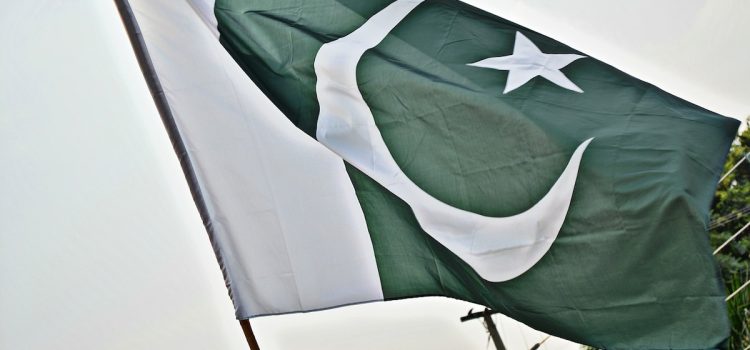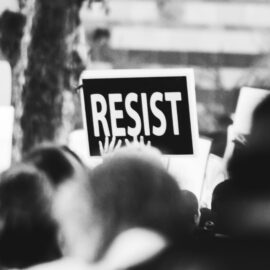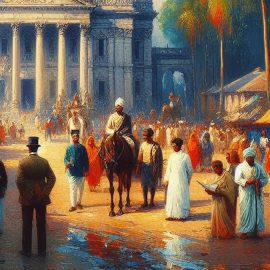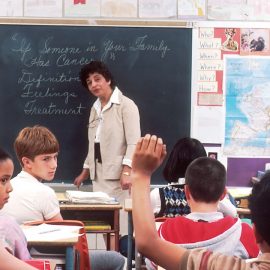
How did the Taliban change the life of a young girl and her society? Why did she speak out against them, at the risk of her own life?
Malala Yousafzai was only 10 years old when the Taliban arrived in her hometown in Pakistan. As their attacks on women’s and girls’ freedoms rapidly escalated, Malala began to speak out against them, even as she and her family faced death threats. When Malala was 15, the Taliban shot and nearly killed her.
Read more to learn about Malala, the Taliban in Pakistan, and why they’re such fierce enemies of each other.
Malala on the Taliban in Pakistan
According to Malala, the Taliban in Pakistan changed her life forever. While her identity was influenced by her family’s positive values, both she and her father were also shaped by the rise of the Taliban during their lifetimes. We’ll first discuss Malala’s perspective on the origins of the Taliban in the 1980s and 1990s. Then, we’ll examine the terrorist group’s increasing power in the Swat Valley after the 9/11 terrorist attacks.
The Origins of the Taliban in Pakistan
In 1977, when Malala’s father was eight, there was a military coup in Pakistan and a general named Muhammad Zia ul-Haq seized control from the elected prime minister. General Zia tried to win the support of the Pakistani people by campaigning to make Pakistan a strict Muslim country and arguing that it was the people’s religious duty to obey his government. Many madrasas were opened during his rule, and Islamic studies became a required class in secular schools. Zia also enacted many laws curtailing women’s rights.
(Shortform note: Britain partitioned Pakistan from India along religious lines—India was primarily Hindu and Pakistan was primarily Muslim. Despite Pakistan’s large Muslim population, however, the government of Pakistan remained secular following its 1947 independence from Britain. For years, Pakistan was divided over the role of Islam in politics. This ended with Zia’s coup. Zia’s “Islamization” of Pakistan went hand in hand with his legal and social programs to reverse women’s rights and emphasize their domestic role as a key aspect of Muslim life.)
Then, the Soviet Union invaded Pakistan’s neighbor, Afghanistan, in 1979. Millions of Afghans fled to Pakistan; General Zia accepted them as refugees and began a program to train them as mujahideen, or resistance fighters. These mujahideen eventually became the Taliban.
(Shortform note: In Arabic, the term mujahideen means anyone who takes part in a jihad, or a struggle for the sake of Islam. In English, mujahideen is more specifically defined as Islamic guerrilla fighters, and jihad means a holy war waged on behalf of Islam as a religious duty.)
Malala writes that, in training these fighters, Zia gained favor with the US, for whom the Soviet Union was the primary enemy in the Cold War. Western countries sent billions of dollars and weapons to help Pakistan’s military intelligence service, ISI, train men to fight the Soviet Union’s Communist army. Zia also gained favor with the Arab world, which saw the Soviet invasion of Afghanistan as an attack by infidels on a fellow Muslim country.
(Shortform note: During the 1980s, the CIA provided $2-3 billion in covert assistance to Pakistan to train 80,000 Afghan mujahideen. Pakistan trained about 90,000 mujahideen in total, including the founder of the Afghan Taliban, Mullah Omar.)
Clerics in the mosques began to preach about the Soviet invasion, saying it was the Pakistani people’s duty as Muslims to join the jihad against the Soviet infidels.
(Shortform note: As a result of this support for jihad, in the mid- to late 1990s, approximately 80,000 to 100,000 Pakistanis fought in Afghanistan on the side of the Taliban. Some sources estimate that 20-40% of Taliban soldiers in Afghanistan were Pakistani. Pakistani political parties recruited volunteer Taliban fighters from the madrasas, which became increasingly militant. In addition, Pakistan provided logistical support and supplies to the Afghan Taliban. After nine years, the Soviet Union withdrew from Afghanistan in 1988-89.)
On September 11, 2001, the terrorist attacks in the US happened. The leader of the al-Qaeda terrorist organization, Osama bin Laden, was living in Kandahar, Afghanistan at the time. America sent thousands of troops to Afghanistan to catch him and overthrow the Taliban regime that had protected him. Just as America had needed Pakistan’s help to fight the Soviets in Afghanistan, it also needed Pakistan’s help to fight the Taliban in Afghanistan. As a result, America embraced General Pervez Musharraf, who was Pakistan’s president at the time and who agreed to help the US with its “War on Terror.”
(Shortform note: The War on Terror is a global military campaign initiated by former US President George W. Bush to combat terrorism following the 9/11 attacks and continued through successive administrations. While the War on Terror succeeded in toppling the Taliban regime in Afghanistan and eliminating many of al-Qaeda’s senior members, including Osama bin Laden in 2011, critics argue that it often employed illegal tactics to do so, including detaining people without trial at Guantánamo Bay, Cuba and using torture to extract confessions.)
Malala writes that, because Pakistan’s intelligence service, ISI, had essentially created the Taliban, many ISI officers were close to Taliban leaders. So, even as Pakistan assisted the Americans, they were still providing weapons to Taliban fighters and sheltering their leaders in Pakistan.
In 2004, the Americans launched a drone attack in a region of Pakistan where they believed Osama bin Laden was hiding. They followed that attack with two more, killing over 100 Pakistanis. As a result of these attacks and Pakistan’s support for the US War on Terror, militancy and anti-government sentiment began to grow within Pakistan. This eventually contributed to the emergence of the Pakistani Taliban.
(Shortform note: Just as many fighters in the Afghan Taliban were Pakistani, many leaders of the Pakistani Taliban were veterans of the war in Afghanistan. These men had long provided support for the fight against the Soviets in Afghanistan. In the late 2000s, spurred on by their anger at Musharraf’s support for America’s War on Terror, they also began to direct their militancy toward their own government.)
Precursors to the Taliban in the Swat Valley
In 2002, the MMA Alliance won the elections in Malala’s province. They were a group of five religious parties, including the one that had run the madrasas where the Taliban were trained. The MMA tore down billboards featuring pictures of women or covered the images with black paint. They took female mannequins from clothing shops and insisted women wear head coverings.
Malala’s father opened his high school in 2003; at the time, boys and girls were in the same classes. But, by the following year, having co-ed classes was no longer an option.
In 2005, a massive 7.6 earthquake hit Pakistan, killing over 73,000 people. The Movement for the Enforcement of Islamic Law, or TNSM—a group that had sent men to fight alongside the Taliban in Afghanistan and was now led by Maulana Fazlullah—provided some aid to remote villages that the government hadn’t been able to help.
Taking advantage of the atmosphere of fear created by the earthquake, mullahs (religious leaders) from the TNSM preached that the earthquake was a punishment from God for women’s freedoms and obscenity.
The Taliban’s Imposition of Increasingly Harsh Sharia Law in the Swat Valley
Malala was 10 when the Taliban came to the Swat Valley, seemingly appearing out of nowhere. The Taliban fighters were armed with knives and Kalashnikovs (assault rifles) and wore black badges that said “Sharia law or martyrdom.”
Their leader was 28-year-old Fazlullah. He set up a radio station in the Swat Valley known as Mullah FM, and people called him the Radio Mullah. Many people in Swat got all of their information from the radio because they didn’t have a TV or were illiterate.
Many people were fed up with the slow-moving and corrupt Pakistani justice system, so they agreed with Fazlullah’s ideas about bringing back Islamic law. Six months after Mullah FM began broadcasting, people started heeding Fazlullah’s admonishments to get rid of their TVs, CDs, and DVDs. The Taliban gathered the electronics in huge piles and burned them in the streets.
Fazlullah often preached directly to women, instructing them to stay home and go outside only in emergencies. Soon, the Radio Mullah was preaching that girls should not go to school. On his radio program, he named girls who had quit school and congratulated them, saying they’d go to heaven. He also told women not to go shopping at the bazaar. If they did try to go, the Taliban would shout at and intimidate them until they went home.
One day, when Malala and her family were passing through a Taliban checkpoint, Taliban soldiers carrying Kalashnikovs told Malala and her mother that their failure to wear Burqas was shameful. When the family returned home, they found a note from the Taliban on the gates of Ziauddin’s school. It threatened severe punishment unless the school stopped teaching girls.
While all this was happening, the authorities and the people did nothing to stop it. Malala’s father said that people had been seduced by Fazlullah. However, clashes between the Taliban and the Pakistani government in Islamabad (the capital of Pakistan) led Musharraf to send the army into the Swat Valley. This was the beginning of a conflict between the army and the Swat Taliban that would last for years.
The army succeeded in driving Fazlullah and his fighters into the mountains, but, within a week, 40 Taliban leaders from across Malala’s province met to form a united front. They called themselves the TTP, or Pakistan Taliban. Besides fighting government forces, they also acted as a morality police, targeting women who weren’t observing purdah.
Benazir Bhutto, a former prime minister who had recently returned from exile, gave a speech in which she condemned the militants. Immediately after the speech, she was assassinated. Many Pakistanis, including Malala, felt that their hope for democracy and women’s rights in the country died along with her.
| Misogyny, Domestic Violence, and Violent Extremism While the Taliban’s violent repression affected everyone in the Swat Valley, it was overwhelmingly directed at women and girls. Research helps explain this link between extremism and violence against women. Some researchers have called misogyny—the hatred of or desire to control women—a “gateway” to extremism. Their studies show that worldwide, men who join violent extremist groups or embrace extremist ideologies are frequently motivated by the promise of a society in which women are subservient to men. By the same token, terrorist groups recruit members by glorifying strict gender roles in which women are relegated to the domestic sphere. In addition, because misogyny dehumanizes women and often goes hand-in-hand with violence against women, it prepares men to accept other violent ideologies and commit violent acts. This may be one reason extremist violence is more likely to take hold in countries like Pakistan, which already have a poor track record when it comes to gender equality. However, research also demonstrates that even in countries like the US where women have more rights, misogyny leads to violent extremism. Studies show that men who have a history of domestic violence commit almost 70% of mass shootings in the US. Experts say that men who believe it’s acceptable to control or abuse women are more likely to commit violent acts against strangers. Author Rebecca Solnit argues in Men Explain Things to Me that the true source of male violence in the US is not mental illness or economic problems, as many claim, but a belief that men have the right to control women. Solnit draws a direct line between misogyny and violence against women, on the one hand, and mass shootings and terrorism, on the other. |
Malala Spoke Out in Support of Girls’ Education and Against the Taliban
Malala continued going to school despite the Taliban’s prohibition on girls’ education. She hid her book bag on the way there and back and didn’t wear her uniform to avoid detection by the Taliban.
The fighting continued in the Swat Valley in 2007 and 2008. Fazlullah started blowing up schools, usually after the night curfew when no one was in them. By the end of 2008, the Taliban had destroyed over 400 schools.
Some of the Pashtun elders in Swat, including Ziauddin, banded together to challenge Fazlullah. They spoke out against the Taliban by giving interviews on radio programs like Voice of America and the BBC. Malala’s father encouraged her to speak up, and she began giving interviews as well.
She started when she was 11 by doing group interviews with her classmates, in which they spoke about girls dropping out of school because of the Taliban. But, when her classmates reached 13 and 14, the men in their families didn’t want them to give interviews anymore because they were afraid the Taliban would punish them for not observing purdah after puberty.
At the end of 2008, the Taliban announced that all girls’ schools must shut down by January 15. On the day Malala’s school shut down, she and her classmates stayed late playing, and then she went home and cried. After that, she did as many TV and radio interviews as she could. She said that the Taliban could close the schools, but they couldn’t stop girls from learning. However, she feared it would be very hard to learn, much less get a job, without school.
After the Taliban banned girls’ education, Pakistanis spoke out in a way they hadn’t before. The Taliban agreed to lift the ban for girls up to 10 years old. Malala was 11, but she and others her age pretended they were younger so they could start going to school again.
Malala’s Family Fled the Swat Valley
Finally, the Pakistani Army launched a more intensive effort to drive the Taliban out of Swat. The government told people to evacuate. Malala’s family left the Swat Valley along with almost two million Internally Displaced Persons (IDPs).
Malala and her family were away from their home for about three months. When they returned, they found buildings in ruins, piles of wreckage, and walls covered with bullet holes. The Taliban was no longer in charge, but Malala feared that they could return at any minute; she had nightmares about it.
Life began to regain a semblance of normalcy. But, just when people started to think the Taliban was really gone, there was a series of bombings, kidnappings, and murders. Ziauddin continued to speak out against the Taliban, and he received another death threat.
Malala’s Profile Continued to Rise
Meanwhile, Malala received many awards for speaking out for girls’ education, and she continued to give interviews to TV and print journalists. During one speech at a gala, she spoke publicly for the first time about defying the Taliban’s orders and going to school in secret.
Malala’s rising profile attracted attention, and she received a death threat from the Taliban. Although her parents were worried and encouraged her to pause her work, Malala wanted to keep speaking out. She reassured herself with the thought that the Taliban had never targeted a young girl.
Malala Was Shot by the Taliban
By the time Malala was 15, she had been speaking out against the Taliban, at increasingly greater personal risk, for four years. She and her family had been receiving threats from the Taliban for a year.
On October 9, 2012, Malala was riding the bus home from school with 19 other girls when Taliban soldiers pulled them over. A man asked for her by name, then shot her in the face point-blank. The bullet went through her left eye socket, exited her head, and lodged in her shoulder, narrowly missing her brain. She survived. The Taliban later claimed responsibility for shooting Malala. They said they had done it, not because of her fight for girls’ education, but because she supported Western, secular ideas.






